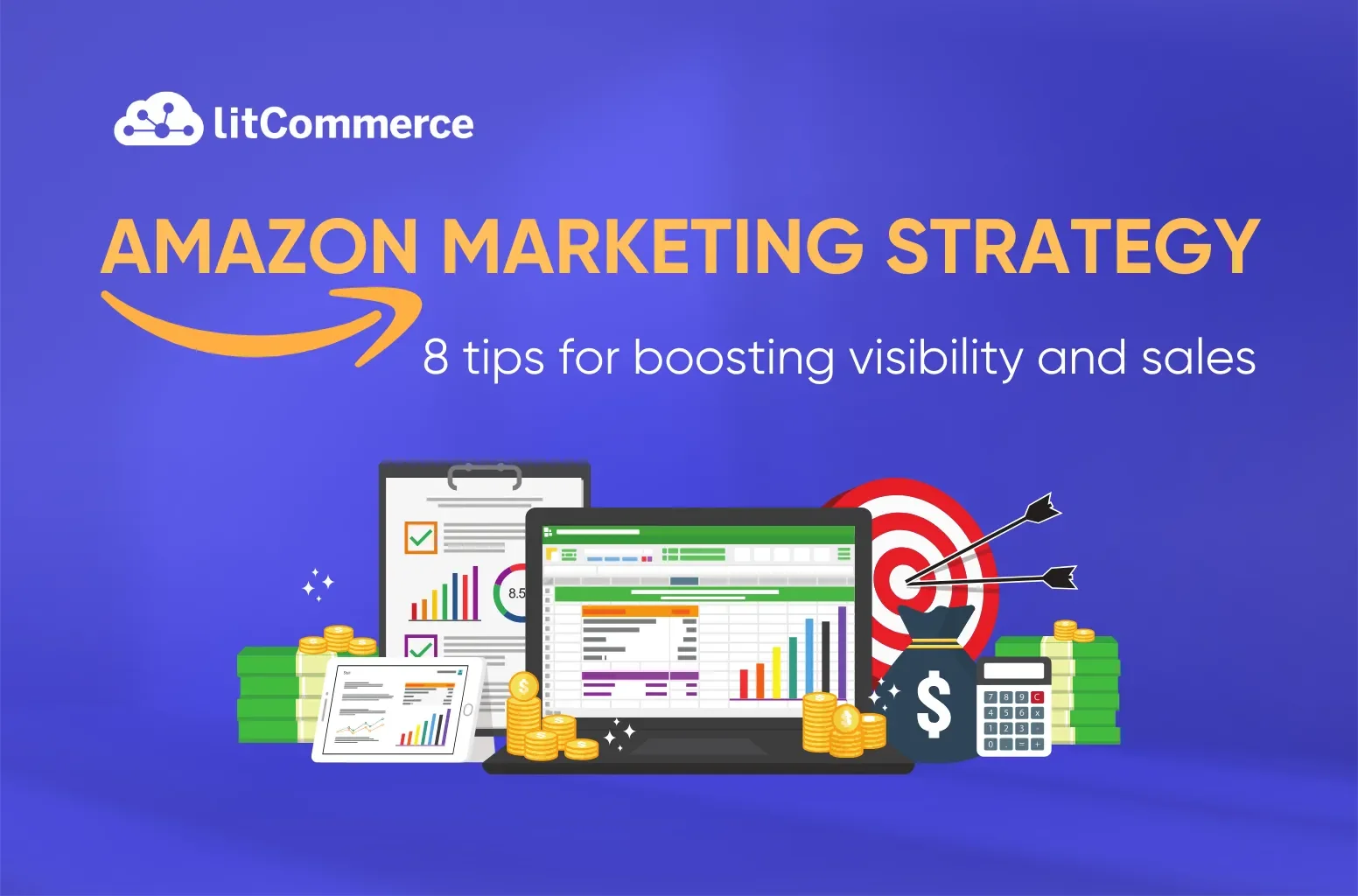A strong Amazon marketing strategy is vital for your eCommerce brand’s success. Even if you have your own website, selling on Amazon can boost your brand’s visibility and profits. But with fierce competition, ranking without a standout strategy is tough. Then, what should you have in your Amazon marketing strategy? Check out this blog to keep up with marking trends, including:
- Take advantage of Amazon ads
- Improve Amazon SEO
- Improve Amazon customer reviews and ratings
- Get the most of Amazon Live
- Invest in high-quality product videos
- Run ads outside Amazon
- Take an omnichannel approach
- Create an Amazon email marketing strategy
So, wait no more! Let’s discuss how to plan your Amazon marketing approach based on 2025’s eCommerce updates.
On-site Amazon Marketing Strategies for Sellers
With Amazon Ads evolving and customer expectations shifting in e-commerce, businesses must revamp their marketing strategies. Here are essential trends to incorporate into your Amazon marketing strategy for 2025 and beyond.
1. Take advantage of Amazon ads
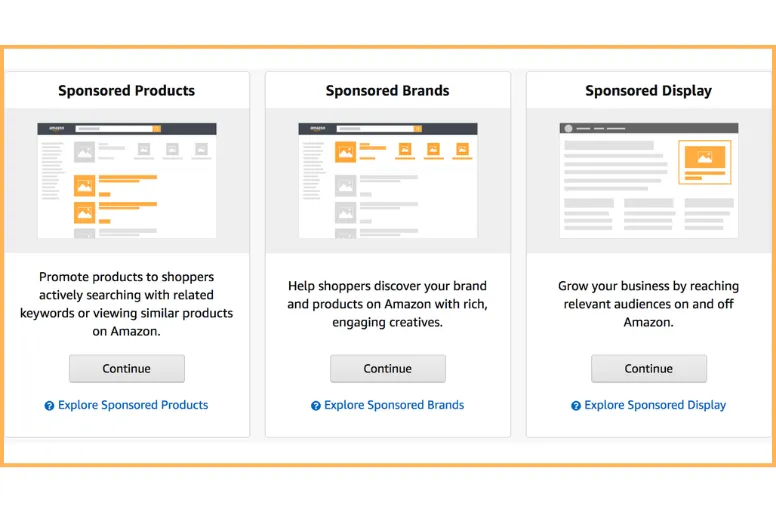
Advertising is crucial across various customer touchpoints on Amazon, especially in competitive categories. Utilizing a mix of Amazon PPC ads is often the most effective approach.
Amazon continues to invest in its advertising offerings, which include expanded targeting options with 3 types of main ads:
- Sponsored products
- Sponsored display
- Sponsored brands
Besides, Amazon has updated more new advertising features to help sellers effectively reach their targeted audience, such as:
- Sponsored display video ads;
- Sponsored brand’s video-only creatives;
- Amazon DSP marketplace targeting;
- AI-powered image generation tool for advertising.
With various advertising options, you should explore and invest in emerging ad types to differentiate your Amazon marketing strategy ad campaigns. When running a campaign, you can follow these two tips to better the result:
- Include deals when advertising
- Analyze the results
#1 – Include deals when advertising
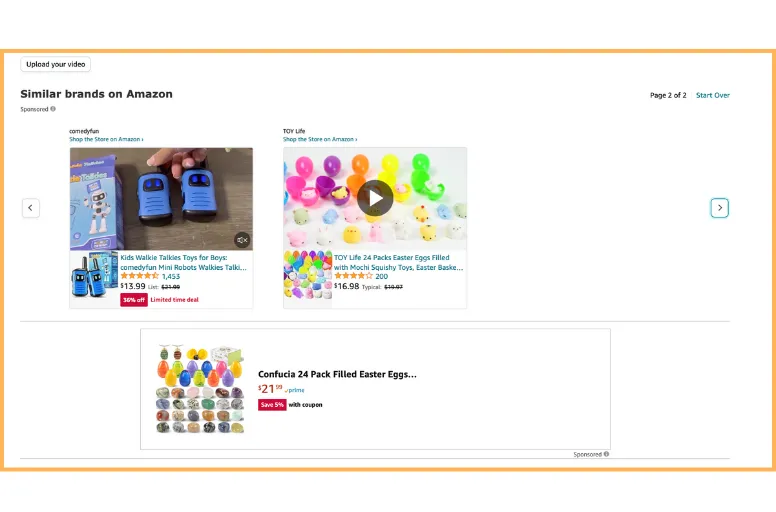
Amazon customers love price reductions and promotions. Offering discounts can quickly capture attention and make buyers feel they’re getting a great deal. Running a coupon alongside advertising is a potent Amazon marketing strategy to increase product visibility, clicks, and conversion rates. However, implementing this tactic requires careful pricing and profit margin analysis to ensure sustainable discount and advertising expenses.
#2 – Analyze the results
To optimize Amazon ad costs while ensuring effective advertising, you better do Amazon marketing strategy analysis regularly. After running your campaigns for two weeks, it’s essential to assess their effectiveness by focusing on specific metrics:
- Return on Advertising Spend (ROAS): Calculate the ROAS for each ad campaign to understand how effectively your advertising dollars are generating sales. This metric helps you identify which Amazon marketing strategy ad campaigns yield the highest returns and which may need adjustments.
- High-performing keywords with low costs: Identify keywords that consistently generate sales at a low cost. These keywords indicate areas where your advertising efforts are particularly efficient. By leveraging these high-performing keywords, you can optimize your ad spend and maximize your ROI.
- Ad placement performance: Evaluate the performance of your ads across different placements on Amazon, such as sponsored products, sponsored brands, and sponsored displays. Determine which placements generate the most clicks, conversions, and ROAS to optimize your ad placement strategy.
- Competitor Analysis: Monitor your competitors’ advertising strategies and performance to identify potential opportunities and threats. You can employ Amazon seller tools like Helium 10 or Jungle Scout to analyze their keywords and targeting tactics to gain insights into industry trends and customer preferences.
2. Improve Amazon SEO

Amazon SEO is a cornerstone of an Amazon marketing strategy, so don’t solely rely on advertising. With 46% of product searches in the US occurring on Amazon, optimizing your listings for Amazon’s search engine is crucial. So, you should ensure your listings are search-friendly. Like Google, Amazon employs its algorithm to prioritize products on the first page. Conquering this algorithm is key to standing out on Amazon.
The elements around this Amazon business marketing strategy include:
- Keyword and backend search terms;
- Keyword-optimized title;
- Product descriptions;
- Image Alt tags;
- Amazon storefront structure.
Optimizing your product listings for the user is crucial. Amazon offers detailed product listing guidelines, but here are some quick optimizations you can make:
- Use bullet points to list main features, making it easier for customers to scan through.
- Utilize high-quality images to showcase your products and their uses effectively.
- Optimize your titles to accurately describe your product within 60-80 characters.
Additionally, you can use Amazon Enhanced Brand Content to provide high-quality images and extra product descriptions to enhance the shopping experience and potentially increase sales.
3. Improve Amazon customer reviews and ratings
Indeed, customer reviews significantly influence your Amazon rankings. The more positive reviews sellers receive, the better ranking results are. Customer ratings are also crucial, as many shoppers filter products by ratings, often opting for items with over 4 stars. Therefore, maintaining positive customer reviews and ratings is an effective Amazon marketing strategy to enhance visibility and boost sales.
To get good customer reviews, you should ensure:
- Product quality
- Excellent customer service
- Clear communication (precise description and transparent policies)
- Timely shipping
You can not ensure that every buyer will leave feedback on their orders. So, if you want to get positive feedback, you can utilize Amazon Vine.
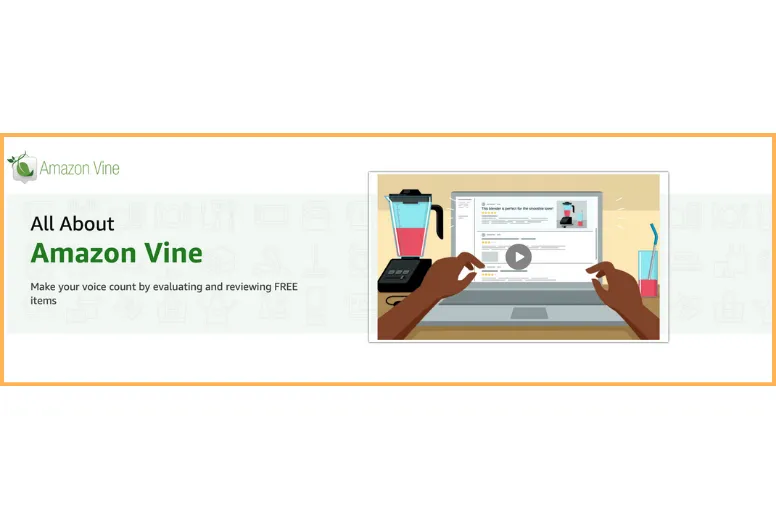
Amazon Vine is an exclusive program that encourages trusted reviewers to provide honest feedback on new products. It’s a valuable opportunity to enhance your review presence, provided you offer high-quality products. Participation in Amazon Vine doesn’t guarantee positive reviews; it simply facilitates the collection of more reviews, regardless of their sentiment. So your job is to offer excellent quality products with exceptional customer service.
To enroll, you’ll need to pay $200 per parent ASIN and provide free products to Vine Voices. Eligible products must be FBA items with fewer than 30 reviews. While you may send more requests than receive reviews, proactive outreach can yield valuable user-generated content, giving you an edge over competitors.
4. Get the most of Amazon Live

Live streaming has become really popular lately, so using Amazon Live as an Amazon marketing strategy to reach a huge audience is a smart move.
And the best part? It’s free! You can broadcast to tons of potential buyers without spending a dime. Just download the Amazon Live Creator app and follow the steps to set up your livestream. Thanks to the product carousel on the Amazon Live page, people can easily buy what they see in the livestream.
Amazon Live is great for showing off your products and making your brand more relatable. Plus, buyers can follow your profile to know when you’re going live next.
Setting up Amazon Live is quick, but getting really good at it might take some practice.
Here are some tips to succeed with Amazon Live:
- Choose your products wisely: The products at the top of your carousel, just below your video, get the most attention. Be strategic about the order you place them in.
- Practice with practice mode: The Live Creator app has a “Practice Mode”. You can use it to test everything out before going live. Use it to get comfortable with the features, audio, and video settings.
- Check specifications: For the best results, stick to Amazon’s recommended video and thumbnail specs. All videos should be viewed in a 16:9 ratio and horizontal orientation.
- Use social media: Share an invitation link on all your social media channels before starting your stream to boost viewership and connect with multiple audiences.
- Collaborate with influencers: Influencers can help promote your livestream to their followers, increasing your visibility and engagement.
5. Invest in high-quality product videos
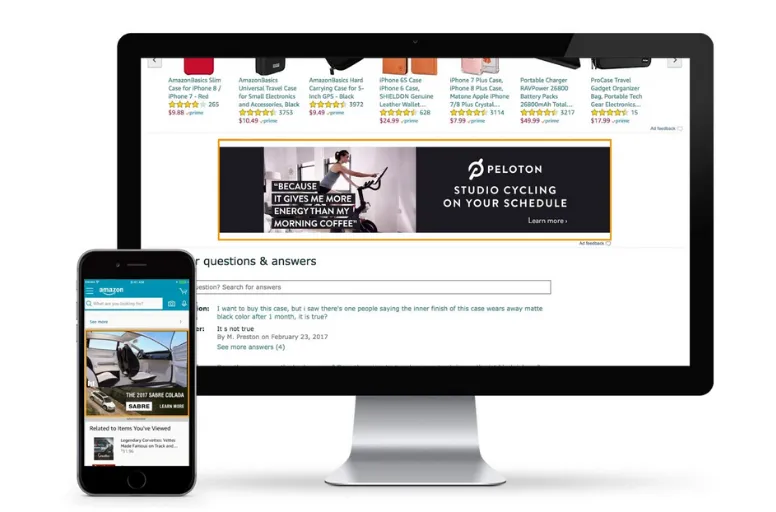
Video marketing is another valuable Amazon marketing strategy handbook that you should consider. As we move into 2025 and beyond, the evolving landscape of the Amazon platform suggests that video will become increasingly valuable for businesses of all sizes. Surveys indicate that 88% of individuals have been persuaded to make a purchase from a brand after watching a video. So, you should incorporate video into product listings and advertising campaigns to inform and convince shoppers to purchase your products.
Customers now have higher expectations for valuable content from the businesses they purchase from, including on Amazon. So, through video marketing, you can:
- Highlight the various uses of your product;
- Showcase intricate details of your product’s design;
- Provide step-by-step walkthroughs on setting up and using your product;
- And much more.
When creating product showcase videos, follow these tips:
- Choose a white or black backdrop for a clean and professional look;
- Limit videos to 30 to 90 seconds.
While filming with a smartphone is possible, using a professional camera or product video production services often yields better results. These options provide high-quality videos highlighting your product’s value and benefits. However, for simpler unboxing or how-to videos, a smartphone can be enough.
Offsite Amazon Digital Marketing Strategies
Besides using Amazon marketing tools, you can expand your reach and enhance your sales through offsite Amazon digital marketing strategies. Below are some updated practices for your next effective Amazon marketing strategy.
6. Run ads outside Amazon

While Amazon offers the option for offsite ads, you can run campaigns on various external platforms like Google, Facebook, Instagram, and TikTok.
Each platform offers distinctive targeting options that can help you reach your target audience effectively. For instance, using Google Ads, you can target users with relevant keywords related to your products. Meanwhile, Facebook and Instagram use demographics, interests, and behaviors to target potential customers.
By running ads outside of Amazon, you can approach more potential customers who may not be actively searching for products on Amazon but could still be interested in what you offer.
A tip for you is to figure out where your customers spend most of their time and start experimenting with ads on one or two platforms at a time. Then, you can decide which one is the most effective choice. If you’re running ads but not seeing the results, start by optimizing your Buy Box strategy.
Along with Amazon listing tool, LitCommerce offers 20+ marketplace integrations. What special? You are able to connect Amazon with multiple sales channels all at once.
7. Take an omnichannel approach
While Amazon remains a dominant eCommerce channel for customers, you should recognize that consumers utilize multiple platforms to learn about brands and businesses. Additionally, customers seek diverse styles of content, such as videos, images, blog posts, and social media content, to understand products better.
Hence, Implementing an omnichannel marketing campaign is crucial for ensuring your product and company reach consumers across various platforms. This Amazon seller marketing strategy guarantees visibility and engagement with consumers wherever they are present. Below are more details on how you can do so.
#1 – Promote on social media platforms

Nowadays, everyone uses social media. Amazon uses social media to advertise its products, so you can do the same. It helps you sell more by sending people to your product pages. Popular platforms for your Amazon marketing strategy include Twitter, Instagram, Facebook, and TikTok.
- Twitter: Good for quick updates, engaging with customers, and sharing links to products.
- Instagram: Ideal for visually showcasing products, influencer collaborations, and leveraging stories and reels for engagement.
- Facebook: Effective for building a community, running targeted ads, and sharing product promotions and updates in groups.
- TikTok: Great for creating viral content, showcasing products in a fun and creative way, and reaching a younger demographic.
#2 – Invest in Amazon Affiliate
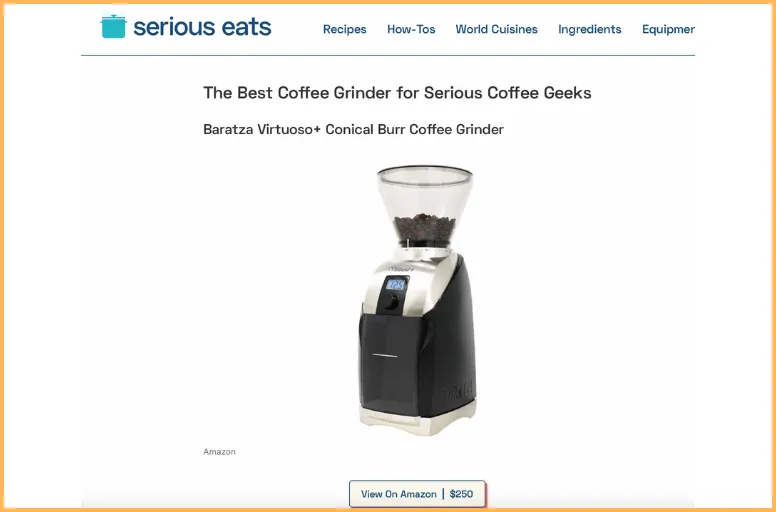
The Amazon Affiliate program benefits merchants, influencers, and Amazon itself. It drives more traffic to your listings, benefiting both you and Amazon. Additionally, Amazon Associates earn commissions on sales they influence.
While participation is automatic, actively reaching out to bloggers, influencers, and site owners can be an Amazon marketing strategy for the promotion of your brand.
To facilitate this:
- Provide instructions for new partners to become Amazon Associates
- Supply them with your ASIN number, product details, and content for marketing your products.
Associates can then create affiliate links and promote your products freely through their Amazon Associates accounts.
8. Create an Amazon email marketing strategy
In 2023, every $1 spent on email marketing was estimated to bring in $36-$40 in return (Omnisend). That’s why every business, including Amazon sellers, should use email marketing.
However, Amazon limits seller interactions with customers, particularly concerning email communication. Though sellers can request reviews via email for FBA orders, Amazon imposes strict guidelines on the content of these messages. Sellers cannot send promotional content, incentives, or external links. Therefore, it is your job to initiate Amazon email marketing by building a potential customer’s email list. Here are some methods you can employ for this Amazon seller marketing strategy:
- Leverage social platforms like Instagram to invite followers to join your newsletter for exclusive updates and deals;
- Host events and social contests and require an email submission;
- Offer gated content requiring users to complete a brief form before gaining access;
- Add opt-ins to your website to notify users of your email subscription.
With email marketing, you can cultivate authentic relationships with your buyers by sending personalized content:
- Shopping guides;
- Product roundups;
- Exclusive deals;
- And recommendations made for their interests.
Sending personalized emails not only advertises your Amazon products but also ensures that your brand stays fresh in customers’ minds. This helps them remember your brand even when they’re not on Amazon.
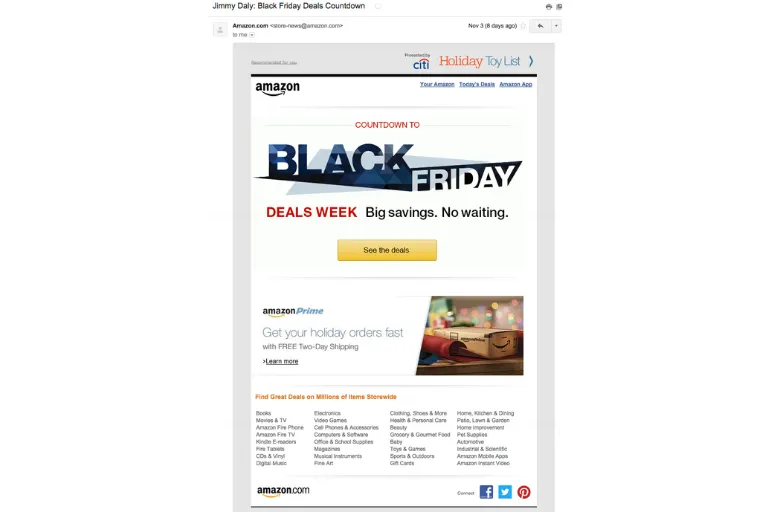
3 Amazon Marketing Strategy Case Studies
An Amazon marketing strategy case study can help eCommerce sellers understand how a well-planned and strategic strategy can help them boost sales and traffic. That’s why we have researched and curated a list of typical successful Amazon marketing strategies for your reference. Keep reading to learn from them.
1. Bagail sees revenue growth with Amazon ads
Many sellers have used Amazon’s display ad solutions for years to enhance brand visibility and drive more sales. For example, Bagail, a travel and home accessories company, strategically employed Amazon’s ad solutions. They saw success in using Sponsored Displays with a vCPM model during promotions.
By using this Amazon marketing strategy, along with the unique voucher feature in Sponsored Display ads, Bagail successfully showcased its latest offers to specific customers with tailored preferences. That helped them engage more potential shoppers, resulting in doubled brand discoverability and a 100% increase in ad-attributed sales.
2. Earth & Elle increases sales with listing optimization
Earth & Elle, a prominent women’s supplement brand on Amazon, sought to improve its sales and customer loyalty through enhanced copywriting and keyword strategy. Facing challenges in the competitive supplements category, they worked with Christina Ink to optimize their Amazon listing.
Christina employed a strategic approach, focusing on relevance and search volume, resulting in a comprehensive keyword list and improved discoverability. They also utilized Amazon A+ Content with high-quality copywriting and images to make Earth & Elle’s page more attractive. As a result, Earth & Elle saw a significant increase in conversions (3%), search volume (20%), and sales (5%), showcasing the effectiveness of the strategy.
3. Little Rainy increased its sales with a unique ad strategy
Little Rainy is an international retailer specializing in women’s fashion. They began selling on Amazon UK in 2017 and swiftly expanded to multiple marketplaces across Europe within a year.
When Little Rainy began selling on Amazon, they used sponsored ads to boost sales. However, they recognized the importance of earning customer trust. To achieve this, they developed a checklist called the “confidence” index, which focuses on establishing sales and positive customer reviews before starting advertising campaigns. Thanks to that Amazon marketing strategy, Little Rainy saw a threefold increase in sales and a 1.17% rise in conversion rate.
Amazon Seller Marketing Strategy: FAQs
The most Amazon marketing strategy revolves around diversification. While its eCommerce business remains a cornerstone, Amazon also generates substantial revenue by enabling third-party businesses to sell on its platform. This approach ensures revenue streams from various sources, mitigating reliance on any single source. You can do marketing with Amazon through various strategies: B2B marketing on Amazon refers to a marketing strategy where businesses market their products to other businesses (B2B) through the Amazon platform. This involves creating listings, advertising campaigns, and storefronts tailored to attract and engage other businesses as customers. B2B sellers on Amazon can offer bulk discounts, negotiate pricing, and provide specialized services to meet the needs of business buyers. B2B marketing on Amazon aims to generate leads and establish long-term business relationships within the Amazon ecosystem. While it’s possible to sell products on Amazon FBA without additional marketing, it can be challenging to achieve significant success solely relying on organic traffic. Implementing Amazon marketing strategies can indeed help your products stand out, increase visibility, and establish brand credibility. It ultimately leads to higher sales and reaching a broader audience. A benchmarking report revealed that advertisers using Amazon Ads’ Sponsored Products campaigns achieved significant cost savings, between 13% and 79% less compared to other advertising options. To analyze the results of your Amazon marketing strategy, you should check various metrics to evaluate its effectiveness. Here are some performance indicators you need to focus on when assessing your Amazon marketing strategy:
Amazon Marketing Strategies: Final Word
Up to date, Amazon is still a crucial platform for eCommerce businesses. Whatever you’re selling, Amazon can showcase your products to your desired customers, boost your reputation, and grow your earnings. However, with the market always changing and more competition, it’s vital to keep developing your Amazon marketing strategy. The tips given can assist you in creating a campaign tailored to the needs of Amazon shoppers this year and in the future.
If you want to read more guides like this, head to our eCommerce blog. LitCommerce team keeps updating best tips and practices to help e-sellers thrive on their selling journey. Should you have any concerns, don’t hesitate to contact us!

